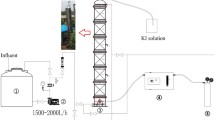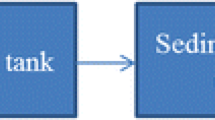Abstract
Molasses wastewaters (MWWs) such as baker’s yeast and distilleries effluents are usually pretreated by anaerobic, followed by aerobic biodegradation. This removes almost all the BOD, enough for meeting the current discharge standards in many low- and middle-income countries. However, as shown in the present work, the biotreated effluent still contains high levels of recalcitrant COD, color (melanoidins) and inorganic salts that end up in rivers (approx. 1000 mg/L COD, 2850 Pt–Co color units, 5000 mg/L TDS and 5400 μS/cm conductivity). To address this global problematics, and given the lack of proven cost-effective advanced treatment trains for MWW, this study assessed the performance and limits of ozonation and activated carbon (AC) adsorption (contrasting with O3 applications on raw MWW). The applied versus the reacted O3 doses were quantified, allowing also to estimate the ozone uptake rate as a new tool for characterizing the reactivity of the wastewaters. The effects of the treatments on different key parameters were studied: COD, color, aromaticity (UV254 nm), toxicity (Microtox) and biodegradability (by respirometry). O3 reduced the color (> 95%), but causing low COD mineralization (< 35%) and biodegradability enhancement (only 8% more). Meanwhile, adsorption was efficient on both COD and color (97–91%), but needing high AC dosage. In consequence, a more sustainable treatment train was suggested, i.e., upgrading the activated sludge with aerobic granular sludge technology and transforming the granules into AC.






Similar content being viewed by others
References
Anwar Saeed M, Ma H, Yue S, Wang Q, Tu M (2018) Concise review on ethanol production from food waste: development and sustainability. Environ Sci Pollut Res 25(29):28851–28863
APHA (2012) Standard methods for the examination of water and wastewater, 22nd edn. American Public Health Association (APHA, AWWA and WPCF), Washington, DC, USA
Arimi MM, Zhang Y, Geisen SU (2015) Color removal of melanoidin-rich industrial effluent by natural manganese oxides. Sep Purif Technol 150:286–291
Bai ZY, Wang JL, Yang Q (2017) Catalytic ozonation of dimethyl phthalate by Ce-substituted goethite. Int J Environ Sci Technol 14:2379–2388
Balcioglu G, Gonder ZB (2018) Baker’s yeast wastewater advanced treatment using ozonation and membrane process for irrigation reuse. Process Saf Environ 117:43–50
Bennett J, Cuttage J (1992) Review and evaluation of Microtox test for freshwater sediments. Report of the Washington State Department of Ecology, Olympia, Washington, DC
Blonskaja V, Zub S (2009) Possible ways for post-treatment of biologically treated wastewater from yeast factory. J Environ Eng Landsc 17(4):189–197
Chandra R, Bharagava RN, Rai V (2008) Melanoidins as major colourant in sugarcane molasses based distillery effluent and its degradation. Bioresour Technol 99(11):4648–4660
Chu LB, Yan ST, Xing HH, Yu AF, Sun XL, Jurcik B (2008) Enhanced sludge solubilization by microbubble ozonation. Chemosphere 72:205–212
Coelho MPM, Moreira-de-Sousa C, de Souza RB, Ansoar-Rodríguez Y, Silva-Zacarin ECM, Fontanetti CS (2017) Toxicity evaluation of vinasse and biosolid samples in diplopod midgut: heat shock protein in situ localization. Environ Sci Pollut Res 24(27):22007–22017
De Kreuk MK, Kishida N, Tsuneda S, van Loosdrecht MCM (2010) Behavior of polymeric substrates in an aerobic granular sludge system. Water Res 44(20):5929–5938
DOF (1997) Norma Oficial Mexicana NOM-001-SEMARNAT-1996. México D.F., México
dos Reis KC, Coimbra JM, Duarte WF, Schwan RF, Silva CF (2019) Biological treatment of vinasse with yeast and simultaneous production of single-cell protein for feed supplementation. Int J Environ Sci Technol 16:763–774
Ekblad M, Falas P, El-taliawy H, Nilsson F, Bester K, Hagman M, Cimbritz M (2019) Is dissolved COD a suitable design parameter for ozone oxidation of organic micropollutants in wastewater? Sci Total Environ 658:449–456
Fall C, Silva-Hernández BC (2017) Bacterial inactivation and regrowth in ozonated activated sludges. Chemosphere 189:357–364
Fall C, Hinojosa-Peña A, Carreño-de-León MC (2007) Design of a monitoring network and assessment of the pollution on the Lerma River and its tributaries by wastewaters disposal. Sci Total Environ 373(1):208–219
Fall C, Millán-Lagunas E, Bâ KM, Gallego-Alarcón I, García-Pulido D, Díaz-Delgado C, Solís-Morelos C (2012) COD fractionation and biological treatability of mixed industrial wastewaters. J Environ Manage 113:71–77
Fall C, Silva-Hernández BC, Hooijmans CM, Lopez-Vazquez CM, Esparza-Soto M, Lucero-Chávez M, van Loosdrecht MCM (2018) Sludge reduction by ozone: insights and modeling of the dose-response effects. J Environ Manage 206:103–112
Fuess LT, Garcia ML, Zaiat M (2018) Seasonal characterization of sugarcane vinasse: assessing environmental impacts from fertirrigation and the bioenergy recovery potential through bio-digestion. Sci Total Environ 634:29–40
Gengec E (2015) Color removal from anaerobic/aerobic treatment effluent of bakery yeast WW by polyaniline/beidellite composite materials. J Environ Chem Eng 3(4):2484–2491
Gengec E, Kobya M (2013) Treatment of baker’s yeast wastewater by electrocoagulation and evaluation of molecular weight with HPSEC. Sep Sci Technol 48:2880–2889
Ghosh Ray S, Ghangrekar MM (2019) Comprehensive review on treatment of high-strength distillery wastewater in advanced physico-chemical and biological degradation pathways. Int J Environ Sci Technol 16:527–546
Gomes AC, Silva L, Simões R, Canto N, Albuquerque A (2013) Toxicity reduction and biodegradability enhancement of cork processing wastewaters by ozonation. Water Sci Technol 68(10):2214–2219
Gutierrez-Segura E, Solache-Rios M, Colin-Cruz A, Fall C (2012) Adsorption of cadmium by Na and Fe modified zeolitic tuffs and carbonaceous material from pyrolyzed sewage sludge. J Environ Manage 97:6–16
Hadavifar M, Younesi H, Zinatizadeh AA, Mahdad F, Li Q, Ghasemi Z (2016) Application of integrated ozone and granular activated carbon for decolorization and chemical oxygen demand reduction of vinasse from alcohol distilleries. J Environ Manage 170:28–36
Henze H, Gujer W, Mino T, van Loosdrecht MCM (2000) Activated sludge models ASM1, ASM2, ASM2d and ASM3. IWA Publishing, London
Hoarau J, Caro Y, Grondin I, Petit T (2018) Sugarcane vinasse processing: toward a status shift from waste to valuable resource. A review. J Water Process Eng 24:11–25
Ikhlaq A, Anis M, Javed F, Ghani H, Munir HMS, Ijaz K (2019) Catalytic ozonation for the treatment of municipal wastewater by iron loaded zeolite A. Desalin Water Treat 152:108–115
Jing X, Li Z (2016) Process research on advanced treatment of yeast wastewater through enhanced catalytic ozonation. J Residuals Sci Technol 13(2):101–109
Kalyuzhnyi S, Gladchenko M, Starostina E, Shcherbakov S, Versprille A (2005) Combined biological and physico-chemical treatment of baker’s yeast wastewater. Water Sci Technol 52(1–2):175–181
Kazak O, Eker YR, Bingol H, Tor A (2017) Preparation of activated carbon from molasses-to-ethanol process waste vinasse and its performance as adsorbent material. Bioresour Technol 241:1077–1083
Lee Y, Von Gunten U (2012) Quantitative structure–activity relationships (QSARs) for the transformation of organic micro-pollutants during oxidative water treatment. Water Res 46:6177–6195
Lopez-Vazquez CM, Oehmen A, Hooijmans CM, Brdjanovic D, Gijzen HJ, Yuan Z, van Loosdrecht MCM (2009) Modeling the PAO-GAO competition: effects of carbon source, pH and temperature. Water Res 43(2):450–462
Marcato ACC, de Souza CP, de Paiva AB, Eismann CE, Navarro FF, Camargo AFM, Menegario AA, Fontanetti CS (2019) Hybrid treatment system for remediation of sugarcane vinasse. Sci Total Environ 659:115–121
Martinez EJ, Rosas JG, Gonzalez R, Garcia D, Gomez X (2018) Treatment of vinasse by electrochemical oxidation: evaluating the performance of boron-doped diamond (BDD)-based and dimensionally stable anodes (DSAs). Int J Environ Sci Technol 15:1159–1168
Metcalf & Eddy (2014) Wastewater engineering: treatment and resource recovery, 5th edn. Mc Graw Hill, New York
Munir HMS, Feroze N, Ikhlaq A, Kazmi M, Javed F, Mukhtar H (2019) Removal of colour and COD from paper and pulp industry wastewater by ozone and combined ozone/UV process. Desalin Water Treat 137:154–161
Nguyen T, Fan L, Roddick FA (2010) Removal of melanoidins from an industrial wastewater. Proceedings of Ozwater 10, Brisbane, Australia, March 8–10, 2010
Nure JF, Shibeshi NT, Asfaw SL, Audenaert W, van Hulle SWH (2017) COD and colour removal from molasses spent wash using activated carbon produced from bagasse fly ash of Matahara sugar factory, Oromiya region, Ethiopia. Water SA 43(3):470–479
Ou D, Li H, Li W, Wu X, Wang Y, Liu Y (2017) Salt-tolerance aerobic granular sludge: formation and microbial community characteristics. Bioresour Technol 198:358–363
Paul E, Debellefontaine H (2007) Reduction of excess sludge produced by biological treatment processes: effect of ozonation on biomass and on sludge. Ozone Sci Eng 29:415–427
Pronk M, Giesen A, Thompson A, Robertson S, van Loosdrecht MCM (2017) Aerobic granular biomass technology: advancements in design, applications and further developments. Water Practice Technol 12(4):987–996
Rahimi E, Shahamat YD, Kamarehei B, Zafarzadeh A, Khani MR (2018) Rapid decolorization and mineralization of molasses by catalytic ozonation process with a nanocomposite from fermentation industry wastewater. Int J Environ Sci Technol 15:1941–1948
Rahimpour A, Jahanshahi M, Peyravi M (2014) Development of pilot scale nanofiltration system for yeast industry wastewater treatment. Health Sci 12, 55
Rakness K, Gordon G, Langlais B, Masschelein W, Matsumoto N, Richard Y, Robson CM, Somiya I (1996) Guideline for measured of ozone concentration in the process gas from an ozone generator. Ozone Sci Eng 18:209–229
Robles-González V, Poggi-Varaldo HM, Galíndez-Mayer J, Ruiz-Ordaz N (2018) Combined treatment of mezcal vinasses by ozonation and activated sludge. Water Environ Res 90(11):1985–1996
Roeleveld PJ, van Loosdrecht MCM (2002) Experience with guidelines for wastewater characterization in The Netherlands. Water Sci Technol 45(6):77–87
Sahu O, Mazumdar B, Chaudhari PK (2019) Electrochemical treatment of sugar industry wastewater: process optimization by response surface methodology. Int J Environ Sci Technol 16:1527–1540
Sigge GO, Green J, du Plessis KR, Britz TJ (2007) Investigating the effect of ozone on the biodegradability of distillery wastewater. S Afr J Enol Vitic 28(2):155–162
Singh N, Petrinic I, Hélix-Nielsen C, Basu S, Balakrishnan M (2018) Concentrating molasses distillery wastewater using biomimetic forward osmosis (FO) membranes. Water Res 130:271–280
Wagner J, Weissbrodt DG, Manguin V, Ribeiro da Costa RH, Morgenroth E, Derlon N (2015) Effect of particulate organic substrate on aerobic granulation and operating conditions of sequencing batch reactors. Water Res 85:158–166
Watt RD, Kirsch EJ, Grady CPL (1989) Ozone consumption kinetics in filtered activated sludge effluents: a modified approach. Water Res 23(4):471–480
Zhang Z, Li D, Zhang X (2019) Enzymatic decolorization of melanoidins from molasses wastewater by immobilized keratinase. Bioresour Technol 280:165–172
Acknowledgements
This study was supported by Autonomous University of the State of Mexico (Grant # UAEM 4781/2019CIB) and by Mexican National Council of Science and Technology (CONACYT scholarship). The authors gratefully acknowledge the industrial WRRF (Reciclagua).
Author information
Authors and Affiliations
Corresponding author
Additional information
Editorial responsibility: M. Abbaspour.
Electronic supplementary material
Below is the link to the electronic supplementary material.
Rights and permissions
About this article
Cite this article
Fall, C., Barrón-Hernández, L.M., Olguín-Gutierrez, M.T. et al. Tertiary treatability of molasses secondary effluents for color and organics: performance and limits of ozonation and adsorption. Int. J. Environ. Sci. Technol. 17, 3651–3662 (2020). https://doi.org/10.1007/s13762-020-02711-2
Received:
Revised:
Accepted:
Published:
Issue Date:
DOI: https://doi.org/10.1007/s13762-020-02711-2




